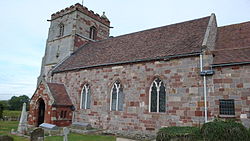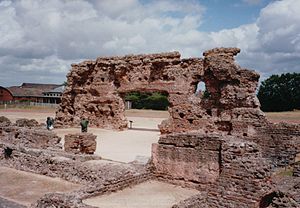Wroxeter
| Wroxeter | |
| Shropshire | |
|---|---|
 St Andrews Church, Wroxeter | |
| Location | |
| Grid reference: | SJ5608 |
| Location: | 52°40’12"N, 2°38’53"W |
| Data | |
| Post town: | Shrewsbury |
| Postcode: | SY5 |
| Dialling code: | 01743 |
| Local Government | |
| Council: | Shropshire |
| Parliamentary constituency: |
Shrewsbury and Atcham |
| Website: | Wroxeter & Uppington Parish Council |
Wroxeter is a village in Shropshire, sitting beside the River Severn, about 5 miles southeast of Shrewsbury. It is at the site of the Roman city of Viroconium Cornoviorum, which was the fourth largest civitas capital in Roman Britain. There are substantial visible remains of the city, dwarfing the village of today.
History
- Main article: Viroconium Cornoviorum
The Roman city of Viroconium Cornoviorum was the fourth-largest tribal capital (civitas) in Roman Britain. The name, "Viroconium of the Cornovians", preserves a native Brittonic name that has been reconstructed as *Uiroconion. The same name is found in the remarkable hill nearby, the Wrekin, a later Anglo-Saxon province named from it, Wrocensæte, and today's village, Wroxeter.
The original site of the Cornovian capital (also thought to have been named *Uiroconion) was a hillfort on the Wrekin.
The relocated Viroconium was established about AD 58 as a fortified camp (castra) for the Legio XIV Gemina during their invasion of the western mountains. The main section of Watling Street, the Roman road, runs across the Midlands between Londinium (London) and Wroxeter.
The 14th Legion was later replaced by the Legio XX Valeria Victrix, which was subsequently relocated to Chester. Around the year 88, the military abandoned the fortress and it was taken over by the Cornovians' civilian settlement. It prospered over the next century, with many public buildings, including thermae (public hot baths) and a colonnaded forum. At its peak, it is thought to have been the 4th-largest settlement in Roman Britain, with a population of more than 15,000.[1]
The 'Old Work' was the name given locally to the vast standing wall of the bath complex. The Roman city was rediscovered in earnest 1859 when workmen began excavating the baths.[2][3][4][5] These are available through the Archaeology Data Service
A replica Roman villa was constructed in 2010 for a Channel 4 television programme called Rome Wasn't Built in a Day and was opened to the public on 19 February 2011.[6]
Following the Roman withdrawal from Britain around 410, the Cornovians seem to have divided into Pengwern and Powys. Viroconium may have served as the early post-Roman capital of Powys prior to its removal to Mathrafal at some time before 717, following famine and plague in the area.
The minor Wrocensæte sub-kingdom also emerged, listed as a Mercian province it is not known whether it remained Wesh-speaking or was an English settlement.
The city appears to be the Cair Guricon which appears in the 9th-century History of the Britons by Nennius, in which Nennius lists the 28 cities of Britain.
St Andrew's
At the centre of Wroxeter village is St Andrew's parish church, some of which is built from re-used Roman masonry. The oldest visible section of the church is the Anglo-Saxon part of the north wall which is built of Roman monumental stone blocks. The chancel and the lower part of the tower are Norman.[7] The gatepiers to the churchyard are a pair of Roman columns and the font in the church was made by hollowing out the capital of a Roman column.[8] Later additions to the church incorporate remains of an Anglo-Saxon preaching cross and carvings salvaged from nearby Haughmond Abbey following the Dissolution of the Monasteries.
The west window, bearing figures of St Andrew and St George, designed by the workshops of William Morris & Co, is a parish war memorial, as is a brass plaque listing parish men who died serving in the First World War, one of whom, Captain C.W. Wolseley-Jenkins, has an individual memorial plaque in the east end.[9]
St. Andrew's was declared redundant in 1980 and is now managed by The Churches Conservation Trust. St. Andrew's parish is now united with that of St Mary, Eaton Constantine.[10]
Literary reference
A E Housman visited the site and was impressed enough to write of "when Uricon the city stood", the poem ending "Today the Roman and his trouble Are ashes under Uricon."[11]
Bernard Cornwell has the main character of the Saxon stories visit Wroxeter in Death of Kings, referring to it as an ancient Roman city that was "as big as London" and using it as an illustration of his pagan beliefs that the World will end in chaos.[12]
Outside links
| ("Wikimedia Commons" has material about Wroxeter) |
References
- ↑ Frere, S. S. Britannia: a History of Roman Britain. London: Routledge & Kegan Paul Ltd., 1987. ISBN 0-7102-1215-1.
- ↑ English Heritage: Wroxeter Roman City
- ↑ Barker, P., Bird, H., Corbishley, M., Pretty, K., White, R. (1997) The Baths Basilica Wroxeter Excavations: 1966-90. English Heritage
- ↑ Chadderton, J., Webster, G. (2002) The Legionary Fortress at Wroxeter: Excavations by Graham Webster, 1955-85. English Heritage
- ↑ Ellis, P (2000) The Roman Baths and Macellum at Wroxeter Excavations 1955-85. English Heritage
- ↑ BBC News Reconstructed Roman villa unveiled at Wroxeter
- ↑ Pevsner, Nicholas, Shropshire, 1958, p. 327
- ↑ Aston & Bond, 1976, page 53
- ↑ Francis, Peter (2013). Shropshire War Memorials, Sites of Remembrance. YouCaxton Publications. pp. 124-125. ISBN 978-1-909644-11-3.
- ↑ Archbishops' Council (2010). "Eaton Constantine S.Mary, Eaton Constantine". A Church Near You. Church of England. http://www.achurchnearyou.com/eaton-constantine-wroxeter-st-mary/. Retrieved 30 January 2011.
- ↑ A. E. Housman, A Shropshire Lad, poem XXXI, 1896
- ↑ Bernard Cornwell, Death of Kings, Part Two - 'Angels', 2012
Books
- Aston, Michael; Bond, James (1976). The Landscape of Towns. Archaeology in the Field Series. London: J M Dent & Sons Ltd. pp. 45–48, 51–54. ISBN 0-460-04194-0.
